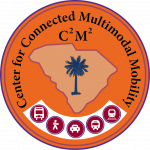This space will showcase products, CPS Devices, Software, models, and publications that are developed by our PIs as part of their Center-sponsored research. Questions and inquiries about these products can be directed to c2m2@clemson.edu.
CVGuard
We have developed software packages for a cyber-attack detection and mitigation platform, CVGuard, which protects CAVs in a vehicle-to-infrastructure (V2I) and infrastructure-to-vehicle (I2V) wireless communication environment by detecting and countering cyber-attacks. This software-based cybersecurity platform leverages three emerging technologies: edge computing, software-defined network (SDN) and network function virtualization (NFV). The primary goal of the platform is to detect and isolate any cyberattacks in a V2I environment before they can negatively affect transportation cyber-physical systems.
CVDeP
We have developed software packages for a scalable and secure connected vehicle (CV) application development platform (CVDeP) that enables CV application developers to build, debug, and test CAV applications in real-time. CVDeP is comprised of the following elements: 1) application management platform; and 2) application development interface. The application management platform is a layer that resides between the user-end and CV edge devices, and is dedicated to controlling access to the edge devices and stored data, and enables heterogeneous wireless network services of the platform. One can develop their connected vehicle applications and deploy the applications directly in the edge-centric CPS via the Graphical User Interface (GUI) of our application development interface. The CVDeP will (a) enable to collect, process and distribute data, and run computation functions of CV applications at different edge layers of the Clemson University Connected Vehicle testbed (CU-CVT) testbed; (b) ensure security of the applications while considering the scalability of the applications; (c) provide an abstraction layer that can hide the underlying low-level software, hardware, and associated details from the developers; and (d) provide a secured access to all the researchers of associated institutions of C2M2 into the CU-CAVT testbed. You can access CVDeP here, on github.
PSMGen
Vehicle-to-pedestrian (V2P) communication can significantly improve pedestrian safety in a connected vehicle environment. However, pedestrian safety is hindered as pedestrians often do not carry hand-held devices (e.g., Dedicated short-range communication (DSRC) and emerging 5G-enabled cell phone) to communicate with nearby connected vehicles. To overcome this limitation, We have developed computer vision-based software packages that process information from video cameras at intersections to generate Pedestrian Safety Messages (PSMs) in real-time to generate a pedestrian warning to alert connected vehicles and pedestrians, and ultimately improve safety while reducing pedestrian-vehicle conflicts. The vision-based approach generates PSMs in real-time following the standard of the society for automotive engineers (SAE), which can be used by any connected vehicle pedestrian safety applications.
AutoNavi
We have developed a unique autonomous vehicle hazard detection and maneuvering approach, which can help autonomous vehicles safely navigate during any unexpected roadway events, caused either by deliberate actions (e.g., roadblock) or unintentional events (e.g., debris), thus improving the safety of autonomous vehicles. We develop a deep neural network (DNN)-based autonomous vehicle driving system using object detection and semantic segmentation to mitigate the adverse effect of these types of hazards.
POSH
We have developed a software for heterogeneous wireless networking of connected vehicles (CVs) called POSH (Prediction based Optimization model for radio access technology Selection and Handover). The software is developed as a python script that can be deployed in the software-defined network (SDN) application layer, on top of the SDN Ryu controller. A convolutional encoder-decoder model is developed to predict the mobility patterns of an area. Based on the predicted mobility patterns and wireless network status, an integer programming problem is developed and solved using the branch and bound method to identify the best access point (AP) or base station (BS) for each CV in the area. The prediction model enables early registration with the new AP/BS and ensures a seamless handover.
Publications
Peer-reviewed publications are one of the many ways that we disseminate our research results, and as such is prioritized by C2M2. We are proud of the work that our funded researchers and their students publish and are happy to do our part to disseminate their efforts. ic segmentation to mitigate the adverse effect of these types of hazards. Click here for a list of our publications.
Databases
Many of our sponsored projects produce vast databases that we publish along with their final reports for other researchers to use. Here are just a few. Others can be found along with our published final reports here.
- Data-driven Multimodal Transportation Energy Consumption Prediction and Analysis Framework for Sustainable Transit and Transportation Planning
- Real Time Classification of Vehicle Types and Modes using Image Analysis and Data Fusion
- Uncertainty Quantification of Cyber Attacks on Connected Vehicles and Infrastructure
